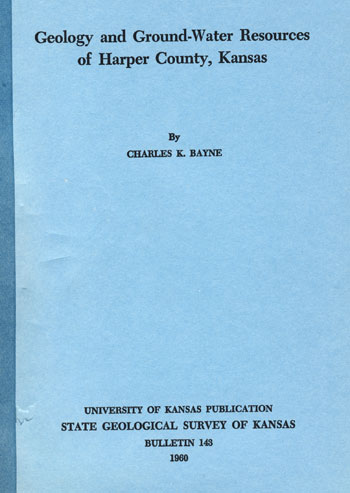Geology and Ground-Water Resources of Harper County, Kansas
By Charles K. Bayne

Originally published in 1960 as Kansas Geological Survey Bulletin 143. This is, in general, the original text as published. The information has not been updated.
You may also wish to visit our web site on the Harper County geologic map.
Abstract
This report describes the geography, geology, and ground-water resources of Harper County in south-central Kansas. The hydrologic and geologic information was obtained in the field during the summers of 1955 and 1956. The field data upon which this report is based are given in tables; they include records of 458 wells and test holes, chemical analyses of 32 water samples from wells and test holes, and 317 logs of wells and test holes.
Harper County lies partly in the Wellington Lowland minor division of the Arkansas River Lowland section of the Central Lowland province and partly in the Red Hills minor division of the Dissected High Plains section of the Great Plains province. A small area in northwestern Harper County lies in the High Plains section of the Great Plains province. The county is drained by Chikaskia River, Bluff Creek, Big and Little Sandy Creeks, and their tributaries. The topography in general slopes southeastward. The normal annual precipitation at Anthony, the county seat, is 27.41 inches. Wheat farming is the principal industry of the county, and oil is the chief natural resource.
The rocks that crop out in Harper County range in age from Paleozoic to Recent. The oldest of these are a part of the Ninnescah Shale of Permian age. Younger Permian rocks that crop out are the Harper Siltstone and the Salt Plain Siltstone. The Permian rocks in Harper County yield small quantities of hard water. Pleistocene deposits, ranging in age from Nebraskan to Recent, unconformably overlie the Permian rocks in the valleys and over much of the upland. These deposits consist of silt, sand, and gravel, and yield moderate supplies of water in parts of the county.
The report contains a map showing the areas of outcrop of the rock formations. The shape and slope of the water table are shown by means of contours; the locations of wells and test holes for which records are given also are shown on maps.
The ground-water reservoir is recharged principally from rain and snow that falls within the county, by percolation from streams and depressions, and by underflow from adjacent areas. Ground water is discharged from the ground-water reservoir by seepage into streams, by transpiration and evaporation, by movement into adjacent areas, and by wells. Water is pumped from wells in Harper County for domestic, stock, municipal, industrial, and irrigation use. Yields as great as 500 gpm can be obtained from wells located in the most productive areas. The results of aquifer tests are included in this report.
Chemical analyses of samples of water from Harper County indicate that the quality varies greatly from place to place. Strong concentrations of sulfate are common in water from the Permian rocks. Water from Pleistocene deposits, although fairly hard, generally is suitable for most uses.
Kansas Geological Survey, Geology
Placed on web Feb. 27, 2009; originally published March, 1960.
Comments to webadmin@kgs.ku.edu
The URL for this page is http://www.kgs.ku.edu/General/Geology/Harper/index.html